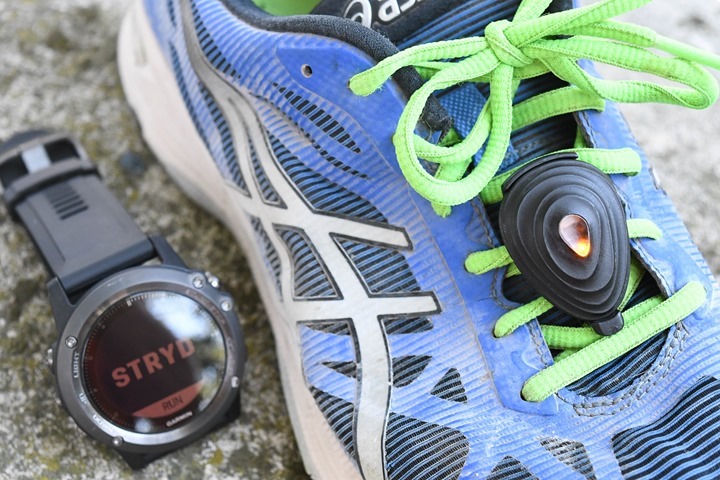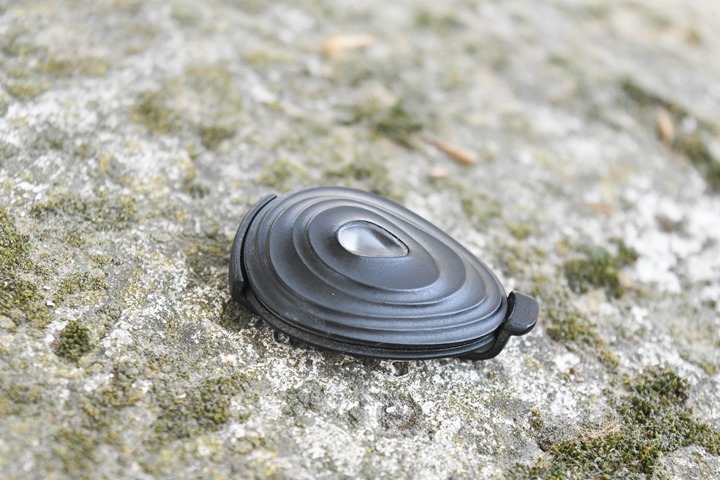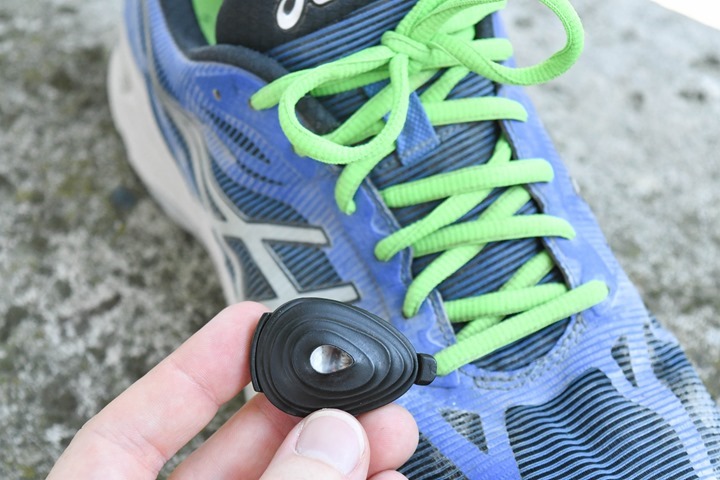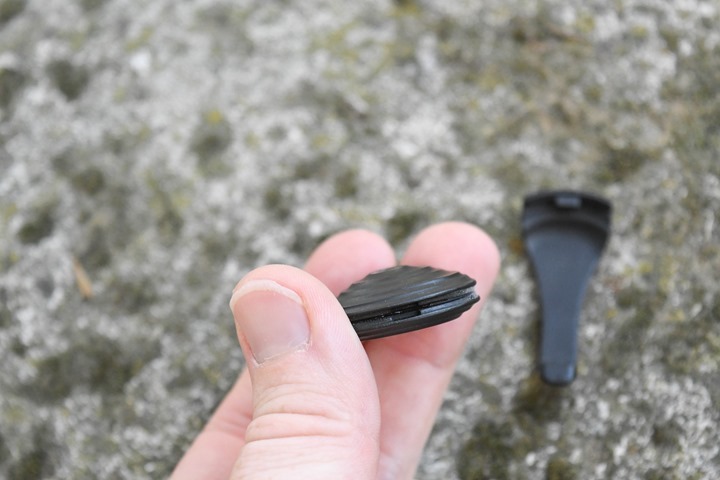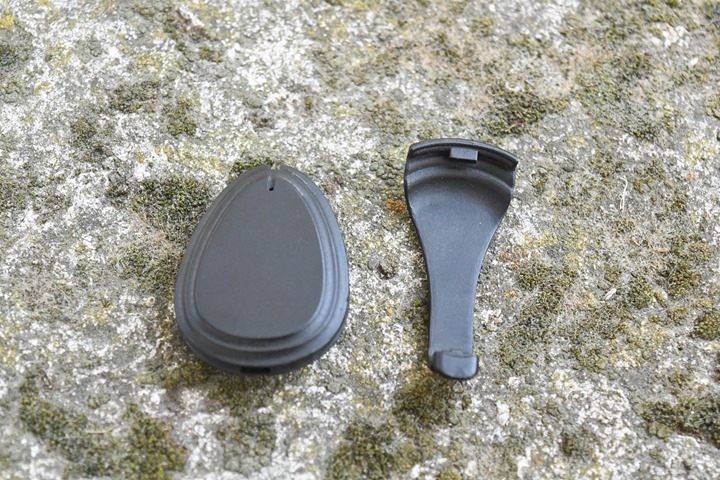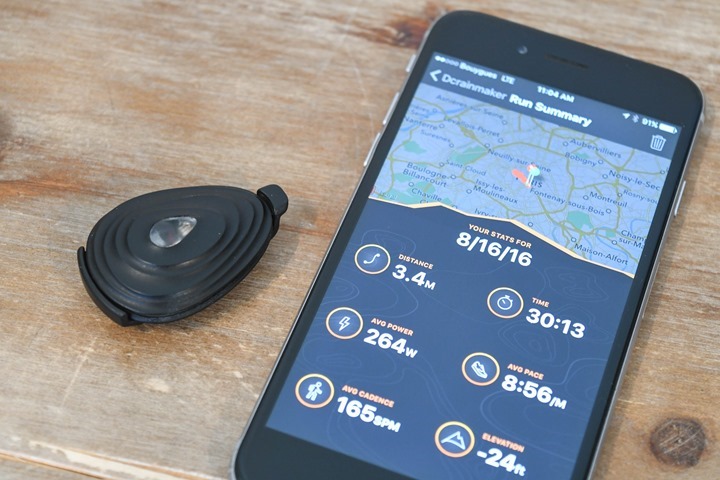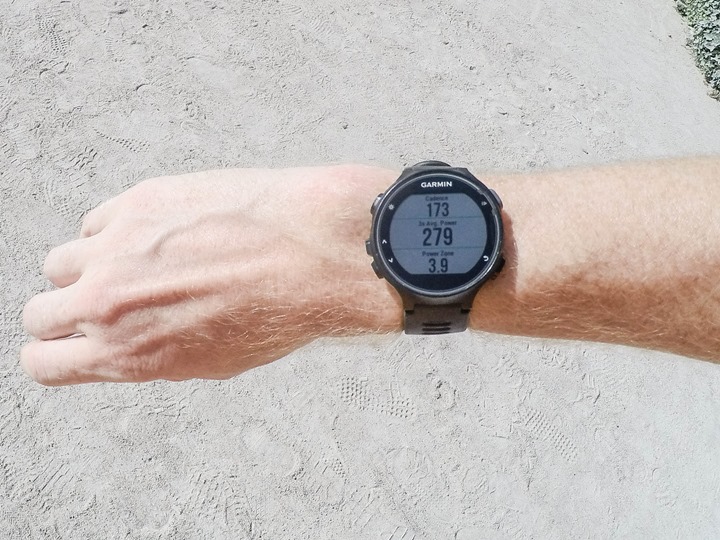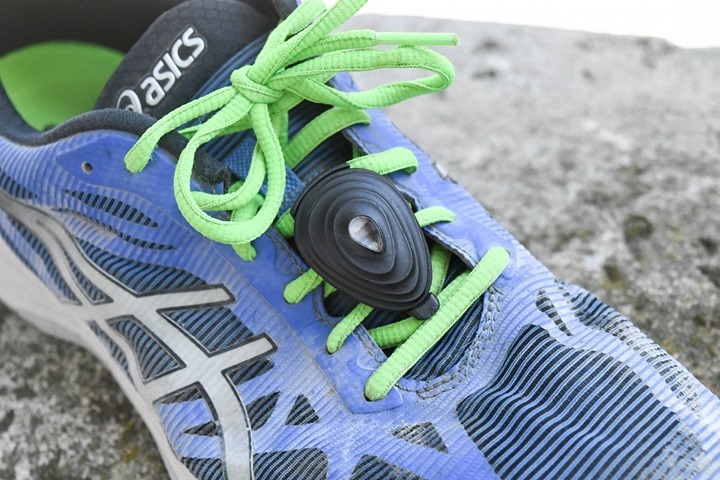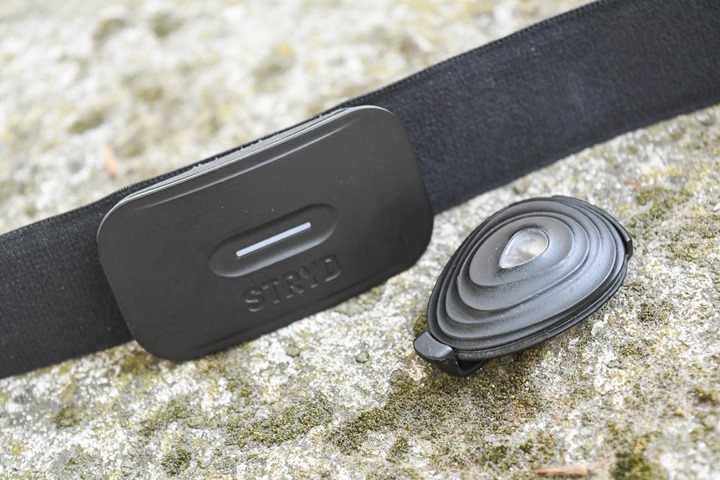Today running power meter company Stryd announced their next generation running power meter unit, changing up the form factor and increasing the data metrics gathered. This new model is now a small footpod that you attach to your running shoe. This differs from the first production generation, which was built into a heart rate strap.
I got the chance to take the unit out for a spin last week, and then analyze the data afterwards with the Stryd folks. Here’s a look at how it all works, and some of my initial thoughts.
The New Hardware:
The new Stryd pod has actually gone back to its roots a bit. If you turn on the way back machine, the initial prototype Stryd units were actually pods, albeit pods clipped to the back of your running shorts. That particular design was super-appealing to many who didn’t want to wear a chest strap. However, by time shipping came on their Kickstarter campaign, the pod had morphed into a chest strap and there was no longer a pod-like option available.
This new version takes that earlier pod idea and improves upon it by placing it on the shoe. That minimizes the (previously highly likely) chance you’d forget about it and let it go through the washing machine still attached to your running shorts.
With this new pod design comes new metrics, and those new metrics take a crapload more processing power than the Gen1 strap units. As such, they’ve had to move away from a coin cell battery, which they would have burned through in just a few hours. Instead, the unit is now rechargeable. The battery should last a month, and as you can see – there’s no charging port. That’s because the thing is using wireless charging instead. Pretty cool, ehh?
You’ll just toss it on it’s little wireless charging pad, and it’ll be good to go. It unclips from your shoe using a standard running footpod clip. Note that this is a pre-prod version, and the final version will look a tiny bit different in terms of styling. My understanding is that it’ll be offered in leopard print or Pokémon patterns only.
Like before, the new pod will transmit running power concurrently on both ANT+ & Bluetooth Smart. And it’ll also store data. This means that it’s compatible with Garmin devices using Connect IQ (or some workarounds for those pre-Connect IQ units). And with recent Suunto devices natively. The Suunto with Stryd experience is definitely still cleaner today than the Garmin experience.
Oh, and lastly – it weighs 7g and is waterproof to 1-meter for 30 minutes (IPX7 essentially).
More Advanced Metrics:
With the new pod and its positioning, comes the ability to measure more than just total power; it now comes with the ability to measure additional metrics: Running Efficiency and Leg Spring Stiffness. Plus they already record Ground Contact Time (GCT) and Vertical Oscillation (VO) on their chest strap, though VO isn’t offered on the footpod. This starts to wade into the same areas of data collection that RunScribe is doing, as well of course Garmin and their HRM-RUN/HRM-TRI straps with similar Running Dynamics metrics.
In addition, they’re also capturing higher quality running speed data using just their internal sensors, like footpods usually do. However unlike a traditional footpod there’s no calibration required, which is in large part due to increased sensors they’ve placed in the pod that measure more data streams that previous footpod devices (largely made by Dynastream). As a result, they believe they’ve made the “most accurate footpod on earth”, and looking at the data from my run, it seems reasonably impressive (more on that down below).
Meanwhile, the new Leg Spring Stiffness & Efficiency metrics (as well as GCT/VO) are only available via the mobile phone and desktop apps after the fact, as Garmin’s implementation of Running Dynamics isn’t open to 3rd parties (pretty much the singular reason why RunScribe ultimately went Bluetooth Smart instead of ANT+). That said, with Connect IQ it would be possible for Stryd to transmit that data over private channels to their own apps for Garmin users. On Suunto devices, Suunto doesn’t currently support secondary non-standard data channels.
The consumer version of the mobile app wasn’t quite ready to show this data yet, though. So instead they demo’d me some charts (below) of how they are thinking of displaying the data, both with my data and other sponsored athletes data. One of the challenges that all of these companies though is how to take rather complex data points and make them meaningful for both training and racing. Said differently: How do you actually get faster from using this data?
They showed some examples of data that demonstrates the differences in leg spring stiffness on both a pro and age grouper athlete from Kona. What’s interesting here is actually more of the fade of the age grouper compared to the pro. Of course, the real catch here is creating guidance that improves these metrics (and ideally finish times for races) for training.
Now folks with knowledge of cycling power meters are probably thinking: Did Stryd just create the first ‘left-only’ running power meter? And the answer to that is basically…yulp.
Because of the fact that Stryd is operating on a single foot, it’s technically only capturing/analyzing the power as extracted from that half of the body. Versus before on the chest it had a more holistic view of power output. This is somewhat the whole Stages/etc left-only power meter debate, but now in running. Stryd says they are definitely looking at being able to have users utilize two Stryd units to start to analyze left/right power differences, but out of the gate the platform is focused on single-leg usage.
They’ve also said they aren’t seeing much differences between single-leg and other placement, but, that’s kinda what left-only power meter companies say too (until they want to sell you dual-leg systems of course – in which case it ‘increases accuracy’).
Still, from a daily logistics standpoint – I much prefer the footpod design to that of a chest strap. So for now I’m willing to consider taking that potential hit in single-leg accuracy versus having to wear a chest strap.
As a side note, they did have a handful of athletes wearing them at the Rio Olympics over the past few weeks. They’re working to get all the approvals in place to publish that data – so that’s something that I suspect could be pretty interesting to see.
An Initial Run:
Last week one of the Stryd engineers was in Paris, so we took the unit out for a bit of a short spin around town. The goal being primarily to capture some data with me running. Given I’m running with just a footpod and watch, there isn’t really a whole lot of photography that you can do there. I had it paired to both the Suunto Spartan Ultra, as well as a Garmin FR735XT. Still, here’s some data using the cycling mode (vs the Stryd App), and showing my power.
Now in my case, the run was a bit of a slower run for my normal paces, as such some of my efficiency is lost at these paces, which is something we later see in the data.
After we downloaded my run using Bluetooth Smart to my existing app, they went ahead and provided a bunch of data charts offline (a few days later). The first shows a breakdown for my power, which is split-up based on changes to my run form versus that of pace or terrain (it doesn’t yet account for wind unfortunately). In such a short 5K run, you wouldn’t see an impact to my running form, as validated below. Whereas if I did a 20-mile run, you’d likely start to see an impact to running form.
The same goes for efficiency, in such a short run – we don’t see much shift. However, the below is interesting as they’ve overlaid one of their folks, Angus, on the graph to the right which shows different efficiency levels for different run paces. This would be something more clearly demonstrated in an interval or varied interval paced workout, where you could start to see patterns and break-points in running efficiency.
Next, when we look at my running stiffness, you’ll see on this run I slotted between the pro athlete and the age grouper. However, it’s probably not a true comparison, given that I only ran 5K at about 30-40% slower than race pace for me. Also, they had just swam 2.4 miles and biked 112 miles. Oh, and they were running in a lava field, and I was running around the Louvre. Same-same, but different. Still, you get the point.
Next are two graphs that demonstrate the updated speed readings from the footpod using their more advanced sensors. This is overlaid against the Garmin speed. The Suunto Spartan speed readings upon export are kinda weird, so, we left those off the chart. However, the plot below includes distance on the Stryd that wasn’t recorded on the GPS (since I had stopped the unit already).
Instead, here’s the three metrics once time-aligned to run start/stop length (1,806 seconds):
Stryd: 5448 m
Garmin 735XT: 5441 m
Suunto Spartan Ultra: 5438 m
So basically, the footpod is within 7-10-meters (with no calibration). That’s incredibly impressive. What’s also impressive is that these two GPS watches were within 3 meters of total distance. I’m reasonably certain I’ve never had that happen. On the flip-side, their tracks differed a bit.
And finally, here’s a chart overlaying Stryd speed accuracy compared to GPS.
But of course the real question is what about power accuracy? Well, that’s a bit trickier. Obviously, I have no secondary reference to go on. But I do have existing Stryd data that I’ve collected over the past year. And for such a perfectly flat course as ours, as well as on a windless day – I can at least get into the right ballpark.
Here’s what that looks like when loaded up into my account on the Stryd Power Center (their website):
What I see here is that the power shows a fair bit higher than I’ve historically seen with the chest strap. Like, a lot higher. Typically speaking my running power and cycling power have been rather closely aligned. Meaning that my Z2 and perceived effort in cycling power (225-250w) is about the same in running. And my FTP power (about 310-315w) is about the same in running. I’d do harder intervals for shorter timeframes above those levels (320-380w). Again, roughly.
Whereas what we see above you see me floating in the 250-300w range, despite running at a much slower pace than normal. Here’s a random zoomed in section for more detail:
In talking with Stryd, they’re still digging into the algorithms a bit and working to get them to match as closely as possible. They noted that typically they see very good correlation between the two units, so I’m a bit of an outlier (the story of my life apparently).
(Administrative note: The graphs in this section with white backgrounds are ones they’ve created manually, they are still deciding how to display this data, so the final data pieces you see will probably be different. The black background graphs are from the standard app today.)
Pricing & Availability:
And now for the super-quick section. The retail price will be $199USD, however, they’re also offering a discount to their original Kickstarter backers (the ones to bought the first version). My understanding is that those folks will receive an e-mail shortly with details on how to redeem at the magical price (I don’t have the final lower price yet, but will update this once it shows).
The unit will start shipping in the 2nd or 3rd week of September, which is less than a month from now.
Going Forward:
Regular DCR readers will remember that I had tried out their first iteration of the device very early on in their startup life, and even received and have used the final heart rate strap variant countless times since then. But I never quite got around to writing a review. Why?
Well, I found the whole data processing piece just too cumbersome to deal with in that era, especially if your running watch was a Garmin. For those on Suunto, it was relatively easy. But on the Garmin front, it was a mess (at best). Things have gotten significantly better on the Garmin front, especially in the last 30-45 days with apps being able to record data to .FIT files in a running-like mode. But I still get a lingering feeling that the two companies need to do a better job (with about 75% of the fault lying with Garmin). I just want to be able to use the normal running mode and collect power meter data and show it in Garmin Connect. That’s all. Oh, and then I want apps like Training Peaks and Strava to display that data. No acrobatics required. I just want it to work.
Stryd could bridge much of that gap today by using a Connect IQ data field to record the data (in much the exact same way that Moxy is doing so as of last week). This is different than their dedicated Stryd app, because it allows me to use all the gloriousness that is the regular running mode, versus the more restrictive app modes. Hopefully they’ll consider doing so – as that’d be pretty darn straight forward. Alternatively, Garmin could just do what Suunto has done for about a year now, which is just enable recording of power data in running mode. It’s really rather simple.
In any case, the second issue with my lack of desire to use earlier versions of the product was the heart rate chest strap. However, by moving away from the heart rate strap to the footpod I’m a million times more likely to use it (and thus write a review on it). I’d just leave it on my shoe and remember to charge it once a month. That’s simple, and brilliant. In this era where runners are more and more moving to optical HR sensors, being reliant on a chest strap wasn’t ideal.
With all that said, I’m looking forward to the units starting to ship, as I’m pretty darn likely to actually use it day in and day out, versus just on random occasions. Of course…that still requires it be accurate. And that’s what the in-depth review is for. Dueling chest strap and footpod power meters. Hopefully they match!
Thanks for reading!
























